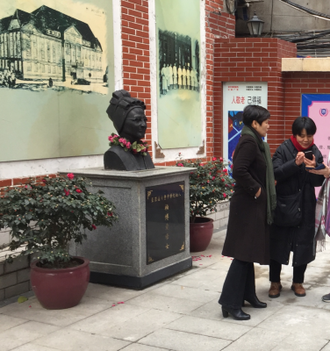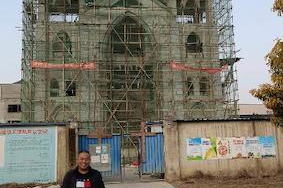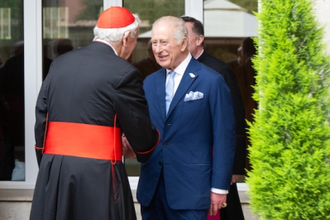China: Wuhan school remembers Catholic founders

Walking into the main building of Wuhan's Number 19 Middle School is like stepping into a different era. The wide corridors, high ceilings and heavy staircases speak of a time when the school's architect, Richard Sachse, must have believed that a spacious design would form hearts and minds of similar proportions to engage creatively with the wider world.
Along the corridors of this school, formerly known as St Joseph's School, are several photographs from a hundred years ago that remind today's teachers and students that they are heirs to a history closely connected with the Catholic Church.
Photographs from as early as 1912 show the Italian Canossian Sisters with their first Chinese students, a clear reminder that the education of girls was a priority for these missionaries.
Four years ago the opportunity for me to visit the school was provided by Sr Teresa, a Canossian Sister from Hong Kong who was bringing friends of her congregation to Wuhan. Normal perceptions of how the Church and modern Chinese institutions interact with each other need to be left out at the street in preparation for a visit of this kind.
The departure of the Canossian Sisters from China 70 years ago should not be assumed to mark the end of their connection with a school that continues to provide education for hundreds of Chinese girls and in more recent years a large number of boys. As happens in so many areas of Chinese life, the nurturing of historical links at a local level is worked out quietly in a way that does not cause upset for those who may have the responsibility to ensure that opinions of a sensitive nature are not overstated.
The photographs that line these corridors are an initial indication that history retains an importance for people in a school that is now run by the civil authorities. As the current principal of the school explained, the modern ethos of the school was shaped in recent decades by a dedicated principal who maintained a deep appreciation for the contribution made by the Canossian Sisters so many years ago.
Our journey to the top floor of the old building brought us along busy corridors where energetic students prepared for their first class of the day. As we entered the spacious top floor we were once again in the midst of the school's history, a well planned museum that combines mural-sized photographs and educational artifacts that tell the story of the school from its foundation up to the present day. In this unique setting a way has been found to link the events of 100 years into a story that students and teachers can appreciate, a story that provides them with a sense of direction rooted in the early contribution of missionaries, a sense of direction that continues to find its way through the ongoing variables of modern Chinese life.
Later we sat down to drink tea with the principal and other teachers in a reception room where deep old windows still bring in an abundance of light. Details of the school's current approach to education were explained. Although promotion of the Chrisitan faith is not allowed in the state's education system, surprises can emerge. Each September the students begin the school year by gathering in the assembly hall. In the opening address the students are welcomed by the principal, encouraged to study well and also reminded that their school was founded by the Canossian Sisters over 100 years ago and that the students have a duty to live according to values that are still cherished by the school.
An indication of what is meant by these values became obvious to us when we were each given a small metal badge containing the school's emblem. One Chinese character dominates the badge. Depending on the context, the character pronounced xin can mean trust, confidence or faith. Combined with other Chinese characters in the printed details of the school, it is used to express the concepts of sincerity, firm belief and trustworthiness. Specific mention is also made of the school's 1912 founding principle of universal love. Presumably the Canossian Sisters who walked away from the here in a daze of uncertainty 70 years ago would now be pleased to know that the school still retains some continuity with their early vision of education.
Later as we arrived at the school's spacious outdoor recreational area we could see that several modern classrooms represent the expansion of education facilities in more recent years. The principal then brought us towards the entrance of the school to view another feature that is rarely seen in China. An inscribed plinth holds a sculpture of Sr.Vincenzina Bellocchio, the founder of the school. This public recognition indicates yet again a deep respect for all that was initiated for the education of Chinese girls in Wuhan over a century ago, a time when such education was revolutionary in a country where footbinding for women had just been outlawed.
COVID-19 has affected the life of this school in the same way as all schools in China have been affected. Students have been at home for several months and online classes have become the norm. However, in recent weeks students from the senior year classes have returned to the school to make final preparations for their state exams.
Our visit to the school concluded that day when Sr Teresa thanked the school principal for the warm welcome we had received and affirmed the friendship that has been rekindled in recent years between the Canossian Sisters and the teachers at the school. As we walked out of the school I found myself still trying to understand how the different parts of this intriguing story can fit together in a setting where the wider political background might predict that it would not be possible.
When September arrives, a new group of students will walk into Wuhan's Number 19 Middle School for the first time. On their first day they will join the older students in the assembly hall for a welcoming ceremony. They will hear about the history of the school and the values that should guide their lives on a daily basis as they grow in wisdom. In the years ahead as they become familiar with the photographs hanging on the walls of these wide corridors and view the displays at the top floor museum, perhaps they will find a way to understand the various echoes of history that can still be heard within this old school building in Wuhan. Gradually they might also understand why a Chinese character associated with the Christian faith is still part of their school's emblem.


















